To Be The Best: The top 100 boxers in the history of The Ring Rankings (20-11)

If you’re new to this on-going series, please read:
The Introduction. (Seriously, if you’re posting questions like “What does the asterisk next to some results mean?” in the comment section, you really need to read this.)
***
We’re down to the final 20 of Cliff Rold’s unique evaluation of The Ring’s 97-year-old divisional ratings and the 100 fighters who faced the best of their respective weight classes and eras during their time in the Bible of Boxing’s rankings.
The men ranking from #20 to #11 are beyond hall of famers. Each is a bonafide all-time great. Many historians believe that one fighter in this group, whose heyday was the late 1930s, is among the top five fighters ever. Six fighters in this group emerged during the past 45 years, so let’s hear it for the modern greats.
***
#20 – Evander Holyfield
Career Record: 44-10-2, 1 No Contest (29 KOs, 2 KOBY)
First Ring Ranking: #8 Cruiserweight (March 1986)
Last Ring Ranking: #5 Heavyweight (January 2004)
Record vs. Ring-rated Opponents: 18-7-2 (12 KOs, 2 KOBY)
Overall Score Rank: 19
Peak Score Rank: 20
Win Total Rank: 41
Ring Magazine Championships: None (See Missing Quality)
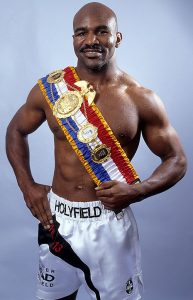
Evander Holyfield was Ring’s 1987, 1996 and 1997 Fighter of the Year. His first fights vs. Riddick Bowe and Mike Tyson were Ring’s 1992 and 1996 Fights of the Year. Photo / Ring Magazine-Gettyimages
Another member of the 1984 Olympic team, Holyfield settled for bronze before a decorated professional career in two weight classes. Holyfield’s dominance of the cruiserweight division in the early part of his career helped legitimize the still-young division. Including supplemental ratings from KO magazine, Holyfield was 7-0 against ranked cruiserweights in his first 18 starts. This included one of boxing’s last 15-round epics with Dwight Muhammad Qawi for Holyfield’s first title.
With The Ring not recognizing the cruiserweight division after 1987, Holyfield rose to No. 2 in the heavyweight rankings in the September 1987 issue after adding his second cruiserweight belt against Rickey Parkey, ultimately unifying the division against Carlos De Leon. In the October 1988 issue, Holyfield became the No. 1 contender to Mike Tyson and remained ranked right behind the recognized champion until Tyson’s shocking upset loss to Buster Douglas, after which Tyson became No. 1 and Holyfield was bumped down to No. 2.
The bump was no matter, as Holyfield assumed the top spot after taking the title from Douglas. Holyfield was 6-0 against ranked heavyweights and was No. 1 in the division when he suffered his first loss to Riddick Bowe. Holyfield resumed the top spot after winning the Bowe rematch and regained it again after the first defeat of Tyson in 1996. Holyfield would hold the top spot for the last time from the February 1997 to July 1999 issues, dropping to No. 2 after a controversial draw in the first Lennox Lewis fight. Altogether, Holyfield would feature in Ring’s top 10 at heavyweight from the July 1987 to August 1994 issues and then again from the October 1995 to January 2004 issues. His mark against ranked opposition at heavyweight would end up at 11-7-2.
Missing Quality: Changes in policy at The Ring cost Holyfield three Ring Magazine championships. The 1987 decision to revert to the “original eight” weight classes discontinued the magazine’s recognition of De Leon before Holyfield got to him. Holyfield would have won Ring titles for the victories over Douglas and Bowe as well. His win over Tyson would not have; the man who beat the man would likely have been Foreman then (though current Ring rankings rules could have seen Foreman stripped). If it had been Foreman, Lewis would have been the defending Ring champion by the time of the Holyfield fights. The draw in the first Lewis fight, a decision Lewis appeared to deserve, gives a slight boost to Holyfield as the official outcome. Regardless, history recalls Holyfield as a three-time lineal champion in two weight classes, along with partial unification of belts in a third heavyweight title reign and an additional title after the loss to Lewis. While all would feature prominently in the rankings before or after facing Holyfield, Alex Stewart, Ray Mercer and John Ruiz were all unranked when Holyfield defeated them.
Scoring Results:
Anthony Davis TKO 4 – (10) – Cruiser – 02/86
Dwight Muhammad Qawi SD 15 – (1) – Cruiser – 09/86
Henry Tillman TKO 7 – (5) – Cruiser – 05/87
Rickey Parkey TKO 3 – (4) – Cruiser – KO Mag 09/87
Ossie Ocasio TKO 11 – (8) – Cruiser – KO Mag 11/87
Dwight Muhammad Qawi KO 4 – (2) – Cruiser – KO Mag 03/88
Carlos De Leon TKO 8 – (2) – Cruiser – KO Mag 07/88
Pinklon Thomas RTD 7 – (10) – Hvy – 02/89
[Michael Dokes TKO 10 – (5) – Hvy
Adilson Rodrigues KO 2 – (3) – Hvy – 05/89]
Buster Douglas KO 3 – (1) – Hvy – 02/91
George Foreman UD 12 – (9) – Hvy – 07/91
Larry Holmes UD 12 – (4) – Hvy – 10/92
Riddick Bowe L 12 – (2) – Hvy – 02/93
Riddick Bowe MD 12 – (1) – Hvy – 02/94
Michael Moorer L 12 – (4) – Hvy – 08/94
Riddick Bowe TKO by 8 – (1) – Hvy – 01/96
Mike Tyson TKO 11 – (1) – Hvy – 01/97
Mike Tyson DQ 3 – (3) – Hvy – 10/97
Michael Moorer RTD 8 – (3) – Hvy – 02/98
Lennox Lewis D 12 – (2) – Hvy – 06/99
Lennox Lewis L 12 – (1) – Hvy – 02/00
John Ruiz L 12 – (UR) – Hvy – 06/01
John Ruiz D 12 – (5) – Hvy – 04/02
Hasim Rahman TD 8 – (4) – Hvy – 10/02
Chris Byrd L 12 – (2) – Hvy – 04/03
James Toney TKO by 9 – (1-) – Cruiser – 01/04
#19 – Sugar Ray Leonard
Career Record: 36-3-1 (25 KOs, 1 KOBY)
First Ring Ranking: #8 Welterweight (November 1978)
Last Ring Ranking: #2 Jr. Middleweight (May 1991)
Record vs. Ring-rated Opponents: 17-2-1 (12 KOs)
Overall Score Rank: 12
Peak Score Rank: 18
Win Total Rank: 49
Ring Magazine Championships: Welterweight (1979-80, 80-82), Jr. Middleweight (1981-82), Middleweight (1987)
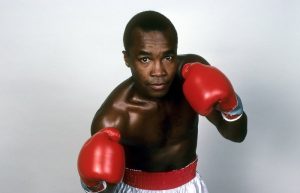
Sugar Ray Leonard was Ring’s 1979 Fighter of the Year and 1981 co-Fighter of the Year (with Salvador Sanchez). His victories over Thomas Hearns and Marvin Hagler were Ring’s 1981 and 1987 Fights of the Year. Photo from The Ring archive
One of five gold medalists on the famed 1976 U.S. Olympic team, Leonard would develop into the biggest star of his time and the best of one of the toughest welterweight fields ever assembled. Blessed with speed, power and killer instinct, Leonard started to test contenders in his 14th bout. On the way to winning his first title, Leonard went 8-0 against opposition ranked from junior welterweight to middleweight. He handed Wilfred Benitez his first defeat for Ring and WBC honors, then later avenged his first loss to regain the welterweight title by forcing Roberto Duran to surrender in the storied “No Mas” fight. Prior to defeating Thomas Hearns in a welterweight unification bout, Leonard added a title in a second division, stopping the undefeated Ayub Kalule.
Leonard would defend only once after Hearns, against Bruce Finch in 1982, then retired following an eye injury. Had Leonard never competed again, his record would have shown a 14-1 mark against ranked opposition and championships in two weight classes.
Leonard didn’t stay retired. He would return only once between his win over Finch and 1987 upset of Marvin Hagler for the middleweight crown, then stayed active after that. Leonard added three more wins against ranked opposition, running his total to titles in five weight classes, before Terry Norris sent him into what looked like his last retirement.
Missing Quality: It was not the last retirement and, while it didn’t count against Leonard here, it is worth a footnote. When Hector Camacho became the only man to stop Leonard in 1997, The Ring ranked Camacho seventh at junior middleweight. In a 40-fight career, Leonard faced ranked opposition in 21 starts. With no opponents ranked before his fight with Floyd Mayweather Sr., it stands out as 21 of his last 27 opponents. Leonard was fortunate to get a draw in the rematch with Hearns and it boosted his score here, but not as much as it might have. Neither The Ring nor KO had a separate top 10 at super middleweight yet for that 1989 bout.
Scoring Results:
Floyd Mayweather Sr. TKO 10 – (6) – 147 – 10/78
Randy Shields UD 10 – (4) – 147 – 12/78
Johnny Gant TKO 8 – (4) – 147 – 03/79
Adolfo Viruet UD 10 – (7-) – 140 – 06/79
Marcos Geraldo UD 10 – (5++) – 160 – 07/79
Tony Chiaverini RTD 4 – (4+) – 154 – 08/79
Pete Ranzany TKO 4 – (5) – 147 – 10/79
Andy Price KO 1 – (8) – 147 – 11/79
Wilfred Benitez TKO 15* – (C) – 147 – 01/80
Dave Green KO 4 – (7) – 147 – 05/80
Roberto Duran L 15* – (2) – 147 – 08/80
Roberto Duran TKO 8* – (C) – 147 – 01/81
Ayub Kalule TKO 9* – (C) – 154 – 08/81
Thomas Hearns TKO 14 – (1) – 147 – 10/81
Bruce Finch TKO 3 – (6) – 147 – 03/82
Marvelous Marvin Hagler SD 12* – (C) – 160 – 07/87
Donny LaLonde TKO 9 – (4++) – 175 – 02/89
Thomas Hearns D 12 – (5) – 160 – 05/89
Roberto Duran UD 12 – (2-) – 160 – 03/90
Terry Norris L 12 – (1) – 154 – 05/91
#18 – Ike Williams
Career Record: 128-24-5 (61 KOs, 6 KOBY)
First Ring Ranking: #10 Lightweight (November 1943)
Last Ring Ranking: #5 Lightweight (November 1951)
Record vs. Ring-rated Opponents: 31-15-2 (16 KOs, 4 KOBY)
Overall Score Rank: 43
Peak Score Rank: 19
Win Total Rank: 10
Ring Magazine Championships: Lightweight (1947-51)
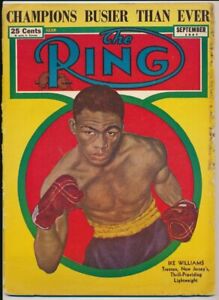
Ike Williams was Ring’s 1948 Fighter of the Year. He owns victories against hall of famers Bob Mongomery, Sammy Angott, Kid Gavilan and Beau Jack.
The best lightweight of the post-war years, Williams was a masterful boxer-puncher whose win-loss mark against ranked opposition makes a case for him as a great welterweight as well. Williams emerged as the best of a memorable trio, going 4-1-1 against Bob Montgomery and Beau Jack in a 10-fight round-robin stretching from 1943-55. The Ring’s lightweight title had been vacant for almost five years following a brief retirement by Sammy Angott in 1942. Along the road to universal recognition as champion, Williams was 2-1 against an Angott later rated at welterweight and captured the NBA title from Juan Zurita in 1945 prior to a unification win over Montgomery, who was recognized as the world lightweight champion by the New York State Commission, in 1947.
Williams’ success against welterweights plays into his finish here and is partly a product of The Ring’s general resistance to ranking fighters in two weight classes at the time. Of the 31 identified wins against Ring-ranked fighters for Williams, 12 came against top 10 welterweights, including a narrow decision over future welterweight champion Kid Gavilan. Williams was one of the few to ever score a knockdown of Gavilan in the win. Williams notched three wins against No. 1-ranked opponents (two at lightweight, one at welterweight) and six more against opponents ranked No. 2 (three each at lightweight and welterweight).
Missing Quality: As evidenced several times already in these pages, notable names don’t always equate to ranked opponents. Beau Jack was unranked when Williams beat him in 1951, and the last two bouts with Jack in 1955, a win and draw, came after both had faded from the rankings. Johnny Bratton was only ranked prior to one of Williams’ three wins over the talented welterweight. Gene Burton, who would be a ranked lightweight and welterweight in the late 1940s and early 1950s, was ranked in only one of his three fights with Williams. It was Williams’ lone loss in the series, though their first fight came just a few bouts into Burton’s career.
Scoring Results:
Lefty LaChance KO 4 – (6-) – 126 – 11/43
Bob Montgomery KO by 12 – (3) – 135 – 03/44
Joey Peralta TKO 9 – (9) – 135 – 05/44
Sammy Angott SD 10 – (4+) – 147 – 07/44
Cleo Shans TKO 10 – (6) – 135 – 08/44
Sammy Angott SD 10 – (3+) – 147 – 10/44
Freddie Dawson KO 4 – (7) – 135 – 11/44
[Willie Joyce L 10 – (4) – 135
Lulu Constantino UD 10 – (9) – 135 – 01/45]
Willie Joyce UD 12 – (6) – 135 – 02/45
Willie Joyce L 12 – (6) – 135 – 04/45
Juan Zurita TKO 2 – (4) – 135 – 06/45
Willie Joyce L 10 – (3) – 135 – 07/45
Sammy Angott TKO by 6 – (UR+) – 147 – 11/45
Wesley Mouzon D 10 – (UR) – 135 – 01/46
Freddie Dawson D 10 – (10) – 135 – 03/46
Enrique Bolanos TKO 8 – (6) – 135 – 06/46
Ronnie James KO 9 – (10) – 135 – 10/46
Gene Burton L 10 – (UR) – 135 – 03/47
Juste Fontaine TKO 4 – (9) – 135 – 07/47
Tippy Larkin KO 4 – (2+) – 147 – 08/47
Bob Montgomery TKO 6* – (1) – 135 – 09/47
Tony Pellone UD 10 – (5+) – 147 – 01/48
Freddie Dawson MD 10 – (3) – 135 – 03/48
Kid Gavilan UD 10 – (2+) – 147 – 04/48
Rudy Cruz UD 10 – (2) – 135 – 06/48
Enrique Bolanos SD 15 – (1) – 135 – 07/48
Beau Jack TKO 6 – (5+) – 147 – 08/48
Jesse Flores TKO 10 – (2) – 135 – 11/48
Buddy Garcia TKO 1 – (9) – 135 – 12/48
Kid Gavilan L 10 – (1+) – 147 – 03/49
Kid Gavilan L 10 – (1+) – 147 – 05/49
Enrique Bolanos TKO 4 – (2) – 135 – 09/49
Freddie Dawson UD 15 – (2+) – 147 – 01/50
Johnny Bratton TKO 8 – (4+) – 147 – 03/50
Sonny Boy West KO 8 – (5) – 135 – 04/50
Lester Felton UD 10 – (1+) – 147 – 07/50
George Costner L 10 – (4+) – 147 – 08/50
Charley Salas L 10 – (UR+) – 147 – 09/50
[Charley Salas SD 10 – (6+) – 147
Joe Miceli L 10 – (UR+) – 147 – 11/50]
Joe Miceli SD 10 – (10+) – 147 – 01/51
Rudy Cruz UD 10 – (9) – 135 – 02/51
Joe Miceli L 10 – (7+) – 147 – 04/51
Fritzie Pruden UD 10 – (6+) – 147 – 05/51
Jimmy Carter TKO by 14* – (7) – 135 – 07/51
Don Williams L 10 – (UR+) – 147 – 09/51
Gil Turner TKO by 10 – (5+) – 147 – 10/51
#17 – Pernell Whitaker
Career Record: 40-4-1, 1 No Contest (17 KOs, 1 KOBY)
First Ring Ranking: #9 Lightweight (February 1987)
Last Ring Ranking: #5 Welterweight (May 2000)
Record vs. Ring-rated Opponents: 17-3-1, 1 No Contest (3 KOs)
Overall Score Rank: 9
Peak Score Rank: 12
Win Total Rank: 48
Ring Magazine Championships: None (See Missing Quality)
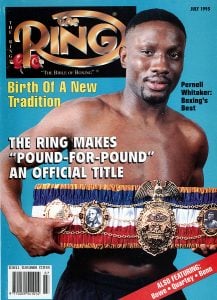
Pernell Whitaker was awarded Ring Magazine’s inaugural Pound-for-Pound title belt. He was Ring’s 1989 Fighter of the Year.
A gold medalist on the storied 1984 U.S. Olympic team, “Sweet Pea” wasted little time with prospect fare as a young lightweight. Alfredo Layne, his first ranked opponent, came in Whitaker’s 11th start. Whitaker climbed to The Ring’s No. 1 contender spot in the March 1989 issue on the eve of his rematch with Jose Luis Ramirez and stayed No. 1 until his exit from the division in 1992. Whitaker was 10-1 against ranked opposition in his lightweight years, 8-1 against ranked lightweights, with a win over leading junior lightweight Azumah Nelson.
Whitaker unified the IBF, WBA and WBC belts at lightweight with a 9-1 record in title fights.
Whitaker’s record wasn’t quite as deep above lightweight, but he continued to add quality. His stint at junior welterweight was brief before a four-year run at the top of the welterweight division. Whitaker was 4-0 against ranked welterweights, including his WBC title win over Buddy McGirt prior to his 1997 loss to Oscar De La Hoya. Along with those wins, Whitaker earned an official draw against the leading junior welterweight, Julio Cesar Chavez, as well as a decision over The Ring’s top-rated junior middleweight, Julio Cesar Vasquez. The Vasquez win gave Whitaker sanctioning body titles in four weight classes. Whitaker faced ranked opposition in 20 of his final 35 fights.
Missing Quality: The big stories of Whitaker’s career, affecting his outcome here, are wins many believe were taken from him. The loss to Ramirez in his first title opportunity and infamous draw versus Chavez, arguably Whitaker’s finest hour, remain controversial. In contrast, there are those who think Whitaker got some benefit of the doubt in the first fight with Wilfredo Rivera. Whitaker could have had two Ring championships. Whitaker-Ramirez II was a 1 vs. 2 fight in the ownership transition of The Ring that ended title recognition. The magazine did distinguish Whitaker as “World Champ” following the knockout of Nazario. McGirt was the champion in direct succession to Donald Curry’s unification and would have been The Ring’s champion in 1993. Finally, Whitaker defeated an unranked Roger Mayweather in 1987, notable as Mayweather would return to the rankings at junior welterweight shortly afterward. Mayweather’s final ranking wouldn’t come until 1993.
Scoring Results:
Alfredo Layne UD 10 – (4-) – 130 – 12/86
Jose Luis Ramirez L 12 – (4) – 135 – 06/88
Greg Haugen UD 12 – (1) – 135 – 03/89
Louie Lomeli TKO 3 – (7) – 135 – KO Mag 08/89
Jose Luis Ramirez UD 12 – (2) – 135 – 05/89
Freddie Pendleton UD 12 – (4) – 135 – 05/90
Azumah Nelson UD 12 – (1-) – 130 – 09/90
Juan Nazario KO 1 – (2) – 135 – 11/90
Anthony Jones UD 12 – (6) – 135 – 06/91
Poli Diaz UD 12 – (6) – 135 – 11/91
Jorge Paez UD 12 – (3) – 135 – 01/92
Rafael Pineda UD 12 – (3) – 140 – 11/92
Buddy McGirt UD 12 – (1) – 147 – 06/93
Julio Cesar Chavez D 12 – (1-) – 140 – 12/93
Buddy McGirt UD 12 – (4) – 147 – Winter/94
Julio Cesar Vasquez UD 12 – (1+) – 154 – 06/95
Jake Rodriguez KO 6 – (6-) – 140 – 02/96
Wilfredo Rivera SD 12 – (7) – 147 – 07/96
Wilfredo Rivera UD 12 – (6) – 147 – Holiday/96
Oscar De La Hoya L 12 – (1-) – 140 – 07/97
Andrei Pastraev NC 12 – (10) – 147 – 01/98
Felix Trinidad L 12 – (2) – 147 – 05/99
#16 – Henry Armstrong
Career Record: 149-21-10 (99 KOs, 2 KOBY)
First Ring Ranking: #8 Featherweight (January 1935)
Last Ring Ranking: #7 Welterweight (June 1945)
Record vs. Ring-rated Opponents: 34-17-4 (17 KOs, 1 KOBY)
Overall Score Rank: 34
Peak Score Rank: 22
Win Total Rank: 7
Ring Magazine Championships: Featherweight (1937-38), Lightweight (1938-39), Welterweight (1938-40)
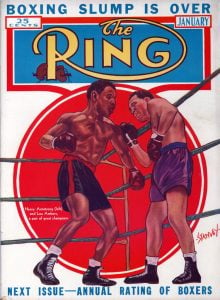
An illustration of Henry Armstrong battling Lou Ambers on the cover of the January 1940 issue of The Ring. Armstrong was Ring’s 1937 Fighter of the Year.
Armstrong’s signature feat remains the stuff of legend and endures as arguably the greatest accomplishment in boxing history. In just 10 months, Armstrong won the featherweight crown from Petey Sarron, jumped up two weight classes to take the welterweight crown from Barney Ross and then captured the lightweight crown from Lou Ambers. The sequence of events only adds to the mystique. On the way there, Armstrong earned the No. 1 contender spot at featherweight from the October 1936 to August 1937 issues before moving into the lightweight rankings for a few months as the No. 2 contender before the Sarron fight.
Armstrong wasn’t unbeatable throughout all of the 10 years he spent in the Ring rankings, but there was a period of time where he looked like it. From the beginning of 1937 until he lost the welterweight title to Fritzie Zivic in 1940, Armstrong went 59-1-1. The lone loss in the stretch, to Ambers in their lightweight title rematch, was decided on point deductions that cost Armstrong five rounds in a fight he otherwise likely would’ve won. The draw came in a challenge of Ceferino Garcia for a version of the middleweight crown. Sixteen of the 59 wins came against Ring-ranked opposition along with a record 19 consecutive defenses of the welterweight crown. While Armstrong is often recalled as past it after the two losses to Zivic, he still managed 11 additional wins against ranked opposition, including wins over Zivic, Willie Joyce and Sammy Angott with several months here and there as the No. 1 welterweight contender as late as the November 1944 issue.
Missing Quality: The volume of fights in Armstrong’s era could sometimes stimulate dramatic shifts in the top 10 from issue to issue. For instance, he stopped Pedro Montanez in a January 1940 welterweight title defense. Montanez came into the fight 24-1-1 in his previous 26 with his lone loss on a cut stoppage to Davey Day. Montanez won three in a row to set up the shot at Armstrong, and yet Montanez was unranked in the issue prior to the fight. Montanez was fifth at welterweight in the January 1940 issue but slipped out of the top 10 in the monthly ratings in the February issue (despite being ranked fifth in the yearly annual rankings in the same issue). Montanez returned to the top 10 in the April issue after the loss. As this study is based on monthly rankings first in the years that had them and this wasn’t the same as the Ross-McLarnin situation, the win wasn’t counted. But it merits mention as one of the best wins of Armstrong’s reign.
Scoring Results:
Baby Arizmendi L 12 – (1) – 126 – 12/34
Joe Conde TKO 7 – (6) – 126 – 01/35
Baby Arizmendi L 12 – (1) – 126 – 02/35
Rodolfo Casanova DQ by 5 – (UR) – 126 – 04/35
Davey Abad L 10 – (UR+) – 135 – 05/35
Frankie Covelli W 8 – (10) – 126 – 06/35
Perfecto Lopez D 8 – (UR) – 126 – 11/35
Midget Wolgast W 10 – (5) – 126 – 01/36
Joe Conde L 10 – (UR) – 126 – 02/36
Richie Fontaine L 10 – (UR+) – 135 – 04/36
Bobby Leyvas TKO 4 – (4-) – 118 – 07/36
Baby Arizmendi W 10 – (2) – 126 – 09/36
Juan Zurita KO 4 – (9) – 126 – 10/36
Mike Belloise W 10 – (2) – 126 – 12/36
Tony Chavez DQ by 8 – (7) – 126 – 01/37
Tony Chavez KO 10 – (6) – 126 – 03/37
[Mike Belloise TKO 4 – (4) – 126
Aldo Spoldi UD 10 – (8+) – 135
Pete DeGrasse KO 10 – (10) – 126 – 05/37]
Petey Sarron KO 6* – (C-) – 126 – 12/37
[Billy Beauhuld TKO 5 – (2+) – 135
Tony Chavez TKO 1 – (6) – 126 – 01/38]
Everett Rightmire TKO 3 – (3) – 126 – 04/38
Barney Ross UD 15* – (C++) – 147 – 07/38
Lou Ambers SD 15* – (C+/-) – 135 – 09/38
Ceferino Garcia UD 15 – (1) – 147 – 01/39
Baby Arizmendi W 10 – (4) -135 – 03/39
Davey Day TKO 12 – (3) – 135 – 05/39
Ernie Roderick W 15 – (2) – 147 – 07/39
Lou Ambers L 15* – (1) – 135 – 10/39
Ceferino Garcia D 10 – (1+) – 160 – 04/40
Paul Junior TKO 7 – (7-) – 135 – 06/40
Lew Jenkins TKO 6 – (C-) – 135 – 09/40
Fritzie Zivic L 15* – (3) – 147 – 11/40
Fritzie Zivic TKO by 12 – (C) – 147 – 03/41
Reuben Shank L 10 – (UR) – 147 – 08/42
Earl Turner KO 4 – (9) – 147 – 11/42
[Juan Zurita KO 2 – (4-) – 135,
Fritzie Zivic UD 10 – (2) – 147 – 12/42]
Willie Joyce L 10 – (5-) – 135 – 04/43
Beau Jack L 10 – (1-) – 135 – 05/43
Sammy Angott UD 10 – (3-) – 135 – 07/43
[Willie Joyce UD 10 – (5-) – 135
Jimmy Garrison W 10 – (7) – 147 – 09/43]
Sugar Ray Robinson L 10 – (1) – 147 – 10/43
[Frankie Wills UD 10 – (6) – 147
Ralph Zannelli UD 10 – (5) – 147 – 05/44]
John Thomas SD 10 – (7-) – 135 – 06/44
[Ralph Zannelli UD 10 – (9) – 147
Willie Joyce L 10 – (6-) – 135
Al “Bummy” Davis TKO 2 – (5) – 07/44]
John Thomas L 10 – (8-) – 135 – 08/44
Slugger White D 10 – (UR) – 147 – 09/44
Chester Slider D 10 – (UR) – 147 – 03/45
Chester Slider L 10 – (7) – 147 – 04/45
#15 – Jose Napoles
Career Record: 81-7 (54 KOs, 4 KOBY)
First Ring Ranking: #10 Jr. Welterweight (March 1963)
Last Ring Ranking: #6 Welterweight (September 1976)
Record vs. Ring-rated Opponents: 20-6 (13 KOs, 4 KOBY)
Overall Score Rank: 14
Overall/Adjusted Highest Score Rank: 16
Overall/Adjusted Win Total Rank: 32
Ring Magazine Championships: Welterweight (1969-70, 71-75)
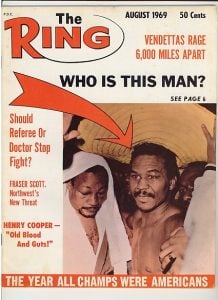
Who is that man? He was Ring’s 1969 Fighter of the Year, that’s who!
Adopted by Mexico, Cuba’s Napoles was a staple of The Ring’s junior welterweight rankings in the 1960s before embarking on one of the great welterweight runs. From the July 1964 to September 1966 issues, Napoles would be ranked No. 1 at junior welterweight for stretches of nine issues twice and was no lower than second during the span, but he never received a title shot. Napoles’ chance would come one division higher and he made the most of it, stopping Curtis Cokes to begin the first of two reigns over the next six years, interrupted only by a loss on a cut to Billy Backus.
Over the years Napoles could be found in the Ring rankings, he defeated six men recognized as champion or ranked No. 1 in their division. In 13 successful title defenses across his two reigns at welterweight, 12 came against Ring-ranked opponents, including former welterweight and middleweight champion Emile Griffith.
Napoles was a road warrior as champion, defending in Canada, France and the U.K. along with several appearances in New York, Los Angeles and Mexico. The only decisive loss Napoles took during his championship years before losing the title to John Stracey was in an ill-fated challenge of middleweight king Carlos Monzon.
Missing Quality: The only welterweight challenger to Napoles who was unranked by The Ring was Ralph Charles. Charles had been ranked for the first half of 1971 on the strength of a win over contender Johann Orsolics but slipped out of the top 10 after a loss to Roger Menetrey. Charles won two straight prior to facing Napoles. Napoles defeated a young Bunny Grant, who would go on to be a staple of the 1960s lightweight rankings, but the win was a couple years too early for credit here. Notably, while Napoles lost to L.C. Morgan on cuts in 1966, he won the other three of their four fights by knockout.
Scoring Results:
Tony Perez L 10 – (UR) – 140 – 02/63
Alfredo Urbina L 10 – (5-) – 135 – 06/63
Alfredo Urbina TKO 1 – (3-) – 135 – 06/64
Carlos Hernandez TKO 7 – (3-) – 135 – 08/64
Eddie Perkins UD 10 – (1) – 140 – 09/65
Adolph Pruitt TKO 3 – (2) – 140 – 01/66
Johnny Santos KO 3 – (6) – 140 – 02/66
LC Morgan TKO by 4 – (UR) – 147 – 02/67
Eugenio Espinoza TKO 6 – (4) – 140 – 02/67
Curtis Cokes RTD 13* – (C) – 147 – 06/69
Curtis Cokes RTD 10 – (1) – 147 – 08/69
Emile Griffith UD 15 – (3+) – 160 – 12/69
Ernie Lopez TKO 15 – (2) – 147 – 04/70
Pete Toro TKO 9 – (9) – 147 – 11/70
Billy Backus TKO by 4* – (2) – 147 – 01/71
Billy Backus TKO 8* – (C) – 147 – 07/71
Hedgemon Lewis UD 15 – (5) – 147 – 01/72
Adolph Pruitt TKO 2 – (1) – 147 – 08/72
Ernie Lopez KO 7 – (4) – 147 – 05/73
Roger Menetrey UD 15 – (2) – 147 – 08/73
Clyde Gray UD 15 – (1) – 147 – 11/73
Carlos Monzon RTD by 6 – (C+) – 160 – 03/74
Hedgemon Lewis TKO 9 – (2) – 147 – 10/74
Armando Muniz TD 12 – (5) – 147 – 05/75
Armando Muniz UD 15 – (4) – 147 – 09/75
John Stracey TKO by 6* – (4) – 147 – 02/76
#14 – Roy Jones Jr.
Career Record: 66-9 (47 KOs, 5 KOBY)
First Ring Ranking: #8 Middleweight (February 1992)
Last Ring Ranking: #5 Light Heavyweight (February 2010)
Record vs. Ring-rated Opponents: 23-6 (13 KOs, 3 KOBY)
Overall Score Rank: 18
Overall/Adjusted Highest Score Rank: 13
Overall/Adjusted Win Total Rank: 25
Ring Magazine Championships: Light Heavyweight (2001-04)
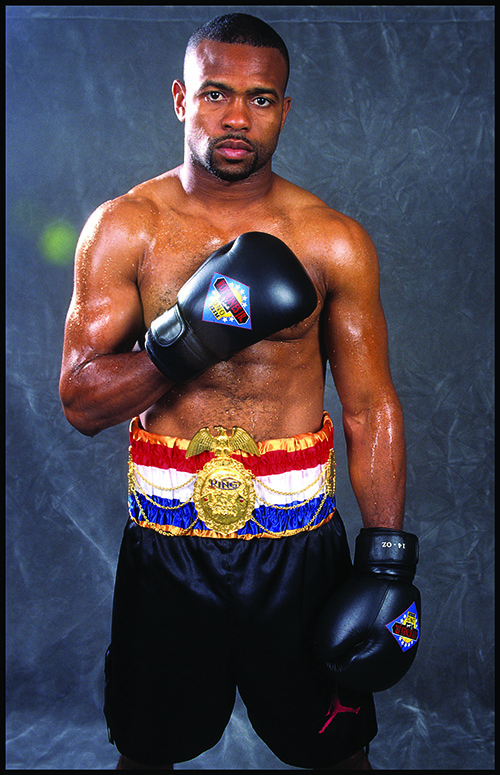
Roy Jones Jr. poses with his Ring Pound-for-Pound belt in 1999. Jones was Ring’s 1994 Fighter of the Year.
Photo: The Ring Magazine/Getty Images
Scandalously denied a gold medal at the 1988 Olympics, Jones combined eye-popping speed, reflexes and power into a package that had some wondering if Jones was the best fighter since Sugar Ray Robinson. Jones would achieve rankings and sanctioning body titles in four weight classes, reaching No. 1 in the first two and recognition as the champion of the third. At his peak, Jones seldom lost a round. He was 23-1 against Ring-ranked opposition after he beat Antonio Tarver. The lone blemish, by disqualification to Montell Griffin, was rectified in a single round.
In those 23 wins, Jones defeated one No. 1-ranked fighter at super middleweight (James Toney) and one at light heavyweight (Tarver). From the November 1997 to November 2002 issues of The Ring, the top two at light heavyweight were Jones and Dariusz Michalczewski. While they never squared off, Jones defeated three third-ranked fighters during those five years and held a 9-3 advantage in terms of wins against Ring-ranked light heavyweights, including defeating the man who would go on to hand Michalczewski his first loss, Julio Gonzalez. Overall, 11 of Jones’ 23 ranked wins came against men ranked in the top five of their weight class when Jones defeated them.
Missing Quality: Several fighters missed out on Ring championships because of the editorial standards in the 1990s; it worked to the benefit of Jones. The 1996 light heavyweight contest between Henry Maske and Virgil Hill was a 1 vs. 2 match and likely would have filled a vacancy in most other eras (and then ended up with Michalczewski). The Ring opted against retroactive designations when it resumed naming single champions again in late 2001 and recognized anyone then holding unified IBF, WBA and WBC belts. It’s why there is an asterisk next to Jones’ win over Reggie Johnson as the win that crowned Jones. Jones defeated some notable names unranked at the time he defeated them. Thulani Malinga and Eric Lucas went on to win titles after losses to Jones, while Jeff Lacy and Felix Trinidad were past their time in the rankings when Jones beat both.
Scoring Results:
Jorge Vaca KO 1 – (8-) – 154 – 04/92
Jorge Castro UD 10 – (8-) – 154 – 10/92
Bernard Hopkins UD 12 – (6) – 160 – 09/93
Thomas Tate TKO 2 – (5) – 160 – 09/94
James Toney UD 12 – (1+) – 168 – 02/95
Vinny Pazienza TKO 6 – (6) – 168 – 10/95
Tony Thornton TKO 3 – (8) – 168 – Winter/1995
Merqui Sosa TKO 2 – (5+) – 175 – 04/96
Bryant Brannon TKO 2 – (7) – 168 – Holiday/1996
Mike McCallum UD 12 – (7+) – 175 – 02/97
Montell Griffin DQ by 9 – (3) – 175 – 06/97
Montell Griffin KO 1 – (3) – 175 – 12/97
Virgil Hill KO 4 – (4) – 175 – 07/98
Lou Del Valle UD 12 – (5) – 175 – 10/98
Otis Grant TKO 10 – (4–) – 160 – 02/99
Reggie Johnson UD 12* – (3) – 175 – 09/99
David Telesco UD 12 – (9) – 175 – 04/00
Richard Hall TKO 11 – (10) – 175 – 07/00
Eric Harding RTD 10 – (3) – 175 – 12/00
Derrick Harmon RTD 10 – (10) – 175 – 06/01
Julio Gonzalez UD 12 – (7) – 175 – 11/01
Clinton Woods TKO 6 – (10) – 175 – 12/02
John Ruiz UD 12 – (5++) – Hvy – 06/03
Antonio Tarver MD 12 – (1) – 175 – 03/04
Antonio Tarver TKO by 2* – (1) – 175 – 09/04
Glen Johnson KO by 9 – (3) – 175 – VII/04
Antonio Tarver L 12 – (C) – 175 – VVI/05
Joe Calzaghe L 12 – (C) – 175 – 01/09
Danny Green TKO by 1 – (UR+) – Cruiser – 02/10
#13 – Jimmy McLarnin
Career Record: 55-11-3 (21 KOs, 1 KOBY)
First Ring Ranking: #3 Featherweight (February 1926)
Last Ring Ranking: #2 Welterweight (August 1937)
Record vs. Ring-rated Opponents: 22-10-1 (8 KOs, 1 KOBY)
Overall Score Rank: 10
Peak Score Rank: 15
Win Total Rank: 26
Ring Magazine Championships: Welterweight (1933-34, 34-45)
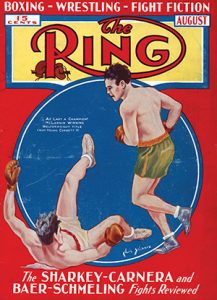
An illustration of Jimmy McLarnin halting Young Corbett III in one round on the cover of the August 1933 issue of The Ring.
Born in Ireland and raised in Canada, the “Belfast Spider” battled the best of his time from featherweight to welterweight. McLarnin would earn the No. 1 contender spot at lightweight in seven of eight issues from April 1928 to November 1928, losing in a title bid versus Sammy Mandell. McLarnin again rose to No. 1 contender at junior welterweight from the February to July 1929 issues before settling at welterweight for good. McLarnin would rank as high as No. 1 and no lower than No. 5 over close to four years before scoring a knockout of Young Corbett III for the welterweight crown in May 1933.
McLarnin would hold the welterweight title twice but never successfully defended it, instead trading it back and forth with Barney Ross over three memorable fights. Ross-McLarnin was just one piece of a four-way, 14-fight rivalry also co-starring Tony Canzoneri and Billy Petrolle. McLarnin would feature in eight of those fights, winning four. During his time in the rankings, McLarnin would post more than a dozen wins over champions or fighters ranked No. 1 at flyweight, lightweight, junior welterweight and welterweight.
Missing Quality: The second defeat versus Ross was technically a loss to an unranked fighter but was not counted as such here. At the time, The Ring avoided ranking fighters in more than one weight division. Despite being a former welterweight champion, when Ross’ recognition as lightweight champion ended in the June 1935 issue he was removed from the rankings just prior to the McLarnin fight. In the spirit of the study, the scoring of that loss for McLarnin reverted to the ranking in the June issue. There were some other big-name moments early in McLarnin’s career. McLarnin’s scoring didn’t include anything in the first half of 1926 or any of 1925, missing a loss to Bud Taylor and a three-fight series with Fidel LaBarba won 2-0-1 by McLarnin before LaBarba entered the rankings at flyweight. McLarnin also defeated future welterweight champion Jackie Fields in 1926 in Fields’ professional infancy.
Scoring Results:
Pancho Villa W 10 – (1–) – 112 – 02/25
[Bud Taylor DQ 2 – (3-) – 118
Bud Taylor L 10 – (3-) – 118
Johnny Farr L 10 – (UR) – 126 – 02/26]
[Joe Glick W 10 – (6) – 130
Doc Snell L 10 – (UR) – 130
Tommy Cello D 10 – (UR) – 135 – 02/27]
[Louis Kaplan KO 8 – (7) – 135
Billy Wallace W 10 – (4) – 135 – 02/28]
Sid Terris KO 1 – (1) – 135 – 03/28
Sammy Mandell L 15 – (C) – 135 – 06/28
Stanislaus Loayza KO 4 – (3) – 135 – 09/28
Ray Miller RTD by 7 (UR-) – 135 – 12/28
Joe Glick UD 10 – (3-) – 135 – 02/29
[Joe Glick KO 2 – (2-) – 135
Ray Miller UD 10 – (1-) – 135 – 04/29]
Sammy Mandell SD 10 – (C–) – 135 – 12/29
Ruby Goldstein KO 2 – (1-) – 140 – 01/30
Sammy Mandell UD 10 – (C–) – 135 – 04/30
Young Jack Thompson UD 10 – (7) – 147 – 05/30
Al Singer KO 3 (C–) – 135 – 10/30
Billy Petrolle L 10 – (4–) – 135 – 12/30
Billy Petrolle UD 10 – (1–) – 135 – 07/31
Billy Petrolle UD 10 – (1–) – 135 – 09/31
Lou Brouillard L 10 – (5) – 147 – 09/32
Sammy Fuller KO 8 – (2-) – 135 – 01/33
Young Corbett III TKO 1* – (C) – 147 – 06/33
Barney Ross L 15* – (C-) – 135 – 07/34
Barney Ross SD 15* – (C) – 147 – 10/34
Barney Ross L 15* – (C-) – 135 – 06/35
Tony Canzoneri L 10 – (C-) – 135 – 06/36
Tony Canzoneri UD 10 – (1-) – 135 – 11/36
Lou Ambers UD 10 – (C-) – 135 – 01/37
#12 – Bernard Hopkins
Career Record: 55-8-2, 2 No Contests (32 KOs, 1 KOBY)
First Ring Ranking: #8 Middleweight (June 1992)
Last Ring Ranking: #3 Light Heavyweight (December 2016)
Record vs. Ring-rated Opponents: 20-6-2, 1 No Contest (8 KOs)
Overall Score Rank: 7
Peak Score Rank: T-10
Win Total Rank: 31
Ring Magazine Championships: Middleweight (2001-05), Light Heavyweight (2006-08, 11-12)

Bernard Hopkins graces the cover of the September 2011 issue of The Ring after becoming the oldest boxer to win a major world title by defeating Jean Pascal. Hopkins was Ring’s 2001 Fighter of the Year.
Boxing’s most recent ageless wonder was unbeaten at middleweight for over twelve years, defending the IBF title successfully 20 times and becoming the first man to hold WBA, WBC, IBF and WBO titles simultaneously. Hopkins’ first title opportunity versus Roy Jones Jr. would be his only defeat at middleweight over the first seventeen years of his career but it wouldn’t be until his third chance that he broke through to the title ranks with a knockout of Segundo Mercado. Including the Mercado win, Hopkins had 13 victories over top-ten middleweights before finally losing his spot in the division to Jermain Taylor. Of those 13 victories, two came against No. 1 contenders while Felix Trinidad entered ranked No. 2 when they competed in the finals of the 2001 middleweight unification tournament. The Trinidad win retroactively filled the vacant Ring championship when Ring reinstated their championship policy.
The middleweight run of Hopkins would have cracked this top 100 on its own but it is the remarkable run at light heavyweight in his 40s that elevated him to these final heights. Hopkins would add five wins against champions and contenders in the division, along with wins over then-middleweight champion Kelly Pavlik and leading middleweight contender Winky Wright. At 41, Hopkins thoroughly defeated Antonio Tarver for his first Ring title at light heavyweight and regained the title in a second fight with Jean Pascal at age 46. The Pascal win made Hopkins the oldest Ring and lineal world champion in history. After losing the world championship to Chad Dawson, Hopkins won two more sanctioning body titles at 48 and 49, the latter unifying the WBA and IBF belts. Of Hopkins six losses during his years in the rankings, none came to a fighter outside the top five. Hopkins exited the rankings for inactivity in 2016 but returned to the ring one last time a few months later and was knocked out at age 51 by Joe Smith Jr. Smith was ranked seventh.
Missing Quality: While the record for consecutive defenses of the linear or Ring Magazine championship at middleweight remains with Carlos Monzon, Hopkins’ 20 IBF title defenses stands as the most for any version of the division’s world titles. It still didn’t capture every fight against a notable name. A No Contest against Robert Allen came before Allen entered Ring’s top ten. Hopkins handed future light heavyweight champion Glen Johnson, then unranked, his first defeat in 1997. It was the only stoppage loss from Johnson’s debut in 1993 until a second stoppage loss in 2014. Hopkins also missed some sort of credit for a rematch victory over Roy Jones in 2010. Jones exited the rankings for the last time following a defeat in his previous fight.
Scoring Results:
Roy Jones Jr. L 12 – (3) – 160 – 09/93
Segundo Mercado D 12 – (UR) – 160 – 03/95
Segundo Mercado TKO 7 – (7) – 160 – 08/95
Joe Lipsey KO 4 – (8) – 160 – 06/96
John David Jackson TKO 7 – (8) – 160 – 08/97
Robert Allen TKO 7 – (7) – 160 – 05/99
Antwun Echols UD 12 – (5) – 160 – 03/00
Antwun Echols TKO 10 – (4) – 160 – 03/01
Keith Holmes UD 12 – (3) – 160 – 08/01
Felix Trinidad TKO 12* – (2) – 160 – 01/02
Carl Daniels RTD 10 – (8) – 160 – 06/02
William Joppy UD 12 – (1) – 160 – 04/04
Robert Allen UD 12 – (2) – 160 – Vol. VI/04
Oscar De La Hoya KO 9 – (2) – 160 – 12/04
Howard Eastman UD 12 – (1) – 160 – 06/05
Jermain Taylor L 12* – (5) – 160 – 10/05
Jermain Taylor L 12 – (C) – 160 – 03/06
Antonio Tarver UD 12* – (C++) – 175 – 09/06
Winky Wright UD 12 – (1–) – 160 – 10/07
Joe Calzaghe L 12* – (C-) – 168 – 07/08
Kelly Pavlik UD 12 – (C–) – 160 – 12/08
Jean Pascal D 12 – (C) – 175 – 02/11
Jean Pascal UD 12* – (C) – 175 – 07/11
Chad Dawson NC 2 – (3) – 175 – 12/11
Chad Dawson L 12* – (2) – 175 – 07/12
Tavoris Cloud UD 12 – (2) – 175 – 05/13
Karo Murat UD 12 – (6) – 175 – 01/14
Beibut Shumenov SD 12 – (4) – 175 – 06/14
Sergey Kovalev L 12 – (2) – 175 – 01/15
#11 – Julio Cesar Chavez
Career Record: 107-6-2 (85 KOs, 4 KOBY)
First Ring Ranking: #7 Jr. Lightweight (August 1984)
Last Ring Ranking: #6 Jr. Welterweight (Holiday 1999)
Record vs. Ring-rated Opponents: 23-4-2 (14 KOs, 2 KOBY)
Overall Score Rank: 11
Peak Score Rank: T-10
Win Total Rank: 24
Ring Magazine Championships: Lightweight (1988-89)
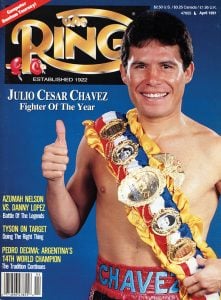
Julio Cesar Chavez graces the cover of the April 1991 issue of The Ring after winning 1990 Fighter of the Year honors.
“El Gran Campeon Mexicano” tore through three weight divisions, officially unbeaten in his first 90 professional starts. Chavez’s first top 10 win was also his first WBC title win just months after entering the rankings at junior lightweight. Chavez would post a mark of 8-0 against the rankings, seven of those wins against top 10 junior lightweights, before moving up the scale. Chavez added a pair of notable wins at lightweight. The first, a battering of Edwin Rosario for a WBA belt, may have been Chavez’s finest performance. Chavez won recognition from Ring as champion after a decision over Jose Luis Ramirez. Chavez’s most dominant run was arguably yet to come.
Chavez was 62-0 when he challenged Roger Mayweather for a WBC title at junior welterweight in May 1989. From that win to Chavez’s first loss to Frankie Randall in January 1994, Chavez went 27-0-1 and bested nine ranked opponents, eight of them ranked junior welterweights. The only blemish was in a draw challenging Pernell Whitaker for the welterweight crown. After regaining the title from Randall in 1994, Chavez would add three more top 10 wins before losing to Oscar De La Hoya to end his time as a champion.
Missing Quality: Fortune and policy might have been all that stood between Chavez holding three Ring championships instead of just one. Rocky Lockridge lost a widely disputed decision against Wilfredo Gomez for the WBA and Ring titles shortly before his loss to Chavez. Assuming everything else unfolds the same way, Chavez could have won Ring’s title from Lockridge in 1986. One doesn’t have to make assumptions about junior welterweight. Chavez’s first win over Meldrick Taylor came with them ranked Nos. 1 and 2 in the division. Under current standards, and most occasions prior to that, Chavez’s last second stoppage would have earned a third divisional crown from Ring.
Scoring Results:
Mario Martinez TKO 8 – (1) – 130 – 10/84
Ruben Castillo TKO 6 – (9-) – 126 – 06/85
Roger Mayweather TKO 2 – (3) – 130 – 08/85
Dwight Pratchett UD 12 – (9) – 130 – 11/85
Refugio Rojas TKO 7 – (9-) – 126 – 08/86
Rocky Lockridge MD 12 – (2) – 130 – 09/86
Juan LaPorte UD 12 – (3) – 130 – 03/87
Francisco Tomas Cruz TKO 3 – (8) – 130 – KO Mag 08/87
Edwin Rosario TKO 11 – (1) – 135 – 02/88
Jose Luis Ramirez TD 11* – (4) – 135 – 01/89
Roger Mayweather RTD 10 – (2) – 140 – KO Mag 08/89
Sammy Fuentes RTD 10 – (5) – 140 – 02/90
Meldrick Taylor TKO 12 – (2) – 140 – 07/90
John Duplessis TKO 4 – (9) – 140 – 06/91
Lonnie Smith UD 12 – (6+) – 147 – 12/91
Frankie Mitchell TKO 4 – (8-) – 135 – 11/92
Hector Camacho UD 12 – (7) – 140 – 12/92
Greg Haugen TKO 5 – (9) – 140 – 06/93
Terrence Alli TKO 6 – (3) – 140 – 08/93
Pernell Whitaker D 12 – (1+) – 147 – 12/93
Frankie Randall L 12 – (UR) – 140 – 04/94
Frankie Randall TD 8 – (1) – 140 – 08/94
Tony Lopez TKO 10 – (6) – 140 – 03/95
Giovanni Parisi UD 12 – (7) – 140 – 07/95
David Kamau UD 12 – (6) – 140 – W/95
Oscar De La Hoya TKO by 4 – (4) – 140 – 09/96
Miguel Angel Gonzalez D 12 – (4) – 140 – 06/98
Oscar De La Hoya RTD by 8 – (1) – 147 – Holiday/98
Willy Wise L 10 – (UR) – 140 – Holiday/99
***
Click here to read 100-91.
Click here to read 90-81.
Click here to read 80-71.
Click here to read 70-61.
Click here to read 60-51.
Click here to read 50-41.
Click here to read 40-31.
Click here to read 30-21.
***
Scoring Details:
Scoring for total points and peak points relied on a base 11-point scale (i.e. a champion and the top 10 contenders).
A win over the champion of one’s weight class, in a title or non-title fight, was worth 11 points, a No. 1 contender was worth 10, etc.
Losses worked in reverse. A loss to the champion was a one-point deduction sliding to 11 for a loss to the No. 10 contender.
Losses to unranked opponents drew a universal 12-point deduction. Draws against ranked opponents were worth half a win; draws against unranked opponents were a six-point deduction.
Fighters were then given a ranking in each scoring category: overall total, peak score (the highest point their points for wins and losses reached), and ranked wins.
Wins and losses to opponents in higher and lower divisions were included. A formula based on body weight percentage differences between divisions of ranked fighters, rather than scale weights of the fighters, was applied.
For instance, if a No. 2-ranked bantamweight defeated the No. 2-ranked featherweight, 126 was divided by 118 and then multiplied by standard win/loss points, making the win worth 9.61 points to the bantamweight and the loss a deduction of 3.2 points for the featherweight. If the featherweight won, 118 would be divided by 126 with the win worth 8.42 points for the featherweight and the loss meaning a deduction of 2.81 points for the bantamweight.
The exception was fighters moving up to face heavyweights. There is no specific heavyweight ceiling so the formula divides the weight limit of the smaller fighter’s division against the actual weight of the heavyweight.
Everyone who finished in the top 100 of preliminary research for those three categories was moved into a final pool of what came out to 150 fighters. Win total ties were broken based on peak score. Their rankings in each category were then averaged into a final score.
To best display the range of data, they were then divided into four groups to settle on the final 100.
Group one: anyone who finished in the top 100 of all three scoring categories or whose scoring average was higher than those who did. (1-64).
Group two was anyone else who finished in the top 100 for peak score and ranked wins but not overall points (65-69).
Group three was derived from fighters who scored in the top 75 of any of the three scoring categories or whose final scoring average was higher than what would otherwise be the bottom ten of the top 100 (70-100).
The final average score was used to order the fighters in each group for those who made the top 100.
The study tried to respect the varying standards The Ring has used to rank fighters over the last century. For instance, champions haven’t automatically secured the top spot in every era of Ring rankings. Mike McTigue was the light heavyweight champion for the inaugural rankings in 1925 and was rated fourth.
For the 1925 rankings, and the period when Ring didn’t recognize single champions from 1989 to 2001, only 10 fighters per weight class were ranked. The points scale shifted for those years. The No. 1-ranked fighter became the 11-point win, deduction for an unranked loss was eleven points, and unranked draws were a 5.5-point deduction.
The 1926 and subsequent annual rankings prior to the introduction of monthly rankings included more than 10 fighters so the first 11 were all factored in.
The study is primarily based on monthly rankings. However, for a lengthy period of time the February, and later March, issue of the magazine would only feature the annual ratings for the year. Those were treated as that month’s rankings and, if needed, were reordered as champion and top 10 to maintain consistency.
Rankings from 1925-1928 had no monthly movement. The solution was to include all results from 1924 in evaluating 1925 and then applying six-month increments with spare exception near mid-year dates until the debut of monthly rankings; i.e. results from January-June 1925 used the 1925 annual and the rest of the year used 1926’s.














